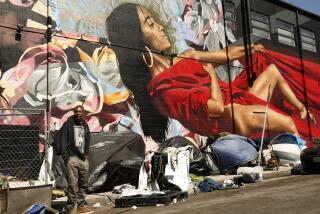Op-Ed: $120 billion in new transportation taxes and we’ll still have potholes?
Perhaps as early as this November, Los Angeles County voters will have the chance to vote on a new transportation sales tax — Measure R2. If it passes, it will increase the county sales tax by half a cent for the next 40 years and raise roughly $120 billion for the county’s transportation future.
Certainly $120 billion can pay for a lot of smart and necessary projects — light-rail extensions, the completion of the Wilshire subway line, new bus lines and bikeways. All of those projects, and more, are covered in the Metropolitan Transportation Authority’s preliminary plan for the R2 money.
In broad terms, Metro is suggesting setting aside 35% of the money for rail, 17% for highway work, 25% for transit and Metro rail operations, and smaller percentages for bike and pedestrian projects, improved paratransit and other needs. The plan also sets aside 16% of the funds for “local return,” which means each of the 88 cities in the county would get a share of $19.2 billion for projects they designate and design.
Unfortunately, Metro’s plan so far earmarks no money for repairing the county’s surface streets, except in a few instances where they may intersect with other projects. And yet L.A.’s surface streets are the foundation of all the other elements in our transportation system. Bikes use streets; buses use them; FedEx, the post office, the police and the fire department use them; even the rail system requires streets to get people to and from the stations, and so will autonomous Ubers, Lyfts and other transportation innovators of the future.
My constituents ... can’t be confronted with a depressing choice between fixing the streets and preserving L.A.’s ability to respond to new transportation needs.
As every Angeleno knows, our streets are in very bad shape. In the city of Los Angeles, motorists spend $1,000 a year in increased repair costs and fuel consumption because of rough and broken roadway surfaces. A third of the city’s streets are in such poor condition that they can no longer be resurfaced with a new layer of asphalt, and must be reconstructed from the gravel base on up. An independent 2013 report by the engineering firm Harris & Associates estimated that it will cost $3.86 billion to bring all streets in the city of Los Angeles into a state of good repair.
The single best way to fund the repair of the city’s failed streets would be to use L.A.’s local return dollars from Measure R2. However, 16% simply isn’t a big enough slice of the pie.
L.A.’s portion of the R2 revenue, based on its population, would amount to about $4 billion. Theoretically, that is enough to pay to fix the streets, but the money won’t come in all at once, and the cost of fixing the streets is estimated to double about every 10 years. The bottom line is that L.A.’s share of the 16% local return can fix only half our streets, and only if we spend all the money as it comes in, with nothing set aside for maintenance (which is how we got the streets we currently have), and with nothing left for any other city-designed transportation project — for the next 40 years.
If my constituents are going to help contribute $120 billion for transportation with every purchase they make, they can’t be confronted with a depressing choice between fixing the streets and preserving L.A.’s ability to respond to new transportation needs. Instead, Measure R2 should mandate a 25% local return, which would provide enough money to fix the streets, keep them in good repair, and still allow for new transportation projects.
A 25% return in general strikes a better balance between regional and local projects for all of the 88 independent cities in Los Angeles County. I suspect many of my colleagues in other cities will want to do as I have proposed in L.A., and dedicate the majority of local return revenue to street repair. But the needs of Long Beach, Pasadena and Torrance may not be the same as those here, or in El Monte, Palmdale or Santa Monica. Each city should have the greatest possible flexibility to decide how to spend revenue from a countywide sales tax that everyone pays. Local mayors and city council members — and the residents they serve — know best which projects are most needed for the neighborhoods in their individual cities.
The future of transportation in Los Angeles County will incorporate bikes, buses, rail, cars and new services we can’t even imagine now. The key to all of it will be a mobility network that is regional in scope yet sensitive to local context. Measure R2 deserves Angelenos’ support, but only if we can ensure that it will provide funds to stabilize L.A.’s now shaky transportation platform — its currently crumbling surface streets — and to meet important city transportation needs far into the future.
Joe Buscaino represents Watts and the 15th District on the Los Angeles City Council.
Follow the Opinion section on Twitter @latimesopinion and Facebook
More to Read
A cure for the common opinion
Get thought-provoking perspectives with our weekly newsletter.
You may occasionally receive promotional content from the Los Angeles Times.






